Dr. April Benasich: Groundbreaking Findings
Dr. April Benasich: Groundbreaking Findings
 Many people dream of making a groundbreaking discovery or of uncovering something that no one else has. TDLC principal investigator Dr. April Benasich, has done just that. Dr. Benasich is among the first scientists to link deficits in rapid auditory processing in infants to later impairments in language and cognition.
Many people dream of making a groundbreaking discovery or of uncovering something that no one else has. TDLC principal investigator Dr. April Benasich, has done just that. Dr. Benasich is among the first scientists to link deficits in rapid auditory processing in infants to later impairments in language and cognition.
As Professor of Neuroscience and the Director of the Infancy Studies Laboratory at the Center for Molecular & Behavioral Neuroscience (CMBN), at Rutgers University in Newark, Dr. Benasich studies brain development in infancy and early childhood, specifically language and cognitive development. The groundbreaking finding mentioned above was a result of a recent study entited "Maturation of auditory evoked potentials from 6 to 48 months: Prediction to 3 and 4 year language and cognitive abilities" (in press, Clinical Neurophysiology). In the study, Naseem Choudhury & April Benasich examine prospectively and longitudinally how EEG/ERPs change over four years. The data gathered from this study is considered so significant, in fact, that the paper was accompanied by an editorial by Shafer and Sussman: "The Choudhury and Benasich study in this issue is one of the few longitudinal studies of early auditory development using ERPs, and arguably the most extensive set of developmental auditory ERP data to date. "
Four New Papers In Press (2010)
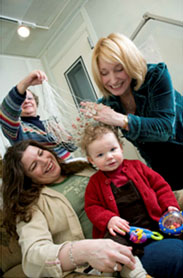 Dr. Benasich and her lab have been inspired and prolific in their work, producing four new papers in press (2010). The paper mentioned above ( "Maturation of auditory evoked potentials from 6 to 48 months: Prediction to 3 and 4 year language and cognitive abilities") by Naseem Choudhury & April Benasich is "in press" in the journal Clinical Neurophysiology. This groundbreaking study examines prospectively and longitudinally how EEG/ERPs change over four years, starting at 6 months and ending when the children are 4 year olds, for two groups of children. One group is comprised of normally developing children without a family history of language disorders and another group contains children at higher risk because they have a sibling or parent with a language learning impairment. So both maturational trajectories and deviance related to risk for language impairment was examined, as well as prediction from early brain wave dates to later language and cognition. As mentioned earlier, the paper was accompanied by an editorial by Shafer and Sussman, emphasizing the importance of these data obtained over five years.
Dr. Benasich and her lab have been inspired and prolific in their work, producing four new papers in press (2010). The paper mentioned above ( "Maturation of auditory evoked potentials from 6 to 48 months: Prediction to 3 and 4 year language and cognitive abilities") by Naseem Choudhury & April Benasich is "in press" in the journal Clinical Neurophysiology. This groundbreaking study examines prospectively and longitudinally how EEG/ERPs change over four years, starting at 6 months and ending when the children are 4 year olds, for two groups of children. One group is comprised of normally developing children without a family history of language disorders and another group contains children at higher risk because they have a sibling or parent with a language learning impairment. So both maturational trajectories and deviance related to risk for language impairment was examined, as well as prediction from early brain wave dates to later language and cognition. As mentioned earlier, the paper was accompanied by an editorial by Shafer and Sussman, emphasizing the importance of these data obtained over five years.
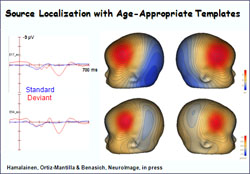 Another paper that is just "in press" in NeuroImage (Jarmo A. Hämäläinen, Silvia Ortiz-Mantilla, April A. Benasich) describes a technique for using age-appropriate MRIs to facilitate accurate source localization of event-related potentials. These images were collected from infants at 6 months using an innovative naturally sleeping MRI technique. Source localization in infants has been difficult given the lack of brain templates for healthy normally developing children. Benasich's lab is also collaborating with Scott Makeig's lab, to develop a more sophisticated developmental brain model to be used in conjunction with EEG/ERPs and MEG. (Please click on the graph for a larger view).
Another paper that is just "in press" in NeuroImage (Jarmo A. Hämäläinen, Silvia Ortiz-Mantilla, April A. Benasich) describes a technique for using age-appropriate MRIs to facilitate accurate source localization of event-related potentials. These images were collected from infants at 6 months using an innovative naturally sleeping MRI technique. Source localization in infants has been difficult given the lack of brain templates for healthy normally developing children. Benasich's lab is also collaborating with Scott Makeig's lab, to develop a more sophisticated developmental brain model to be used in conjunction with EEG/ERPs and MEG. (Please click on the graph for a larger view).
Silvia Ortiz-Mantilla, a TDLC fellow, first-authored a paper that showed for the first time that adults who have learned a second language later in life (after age 10), treat sounds that are not speech differently from early bilinguals or monolinguals. The paper, which is "in Press" in the journal Brain Research suggests that individuals acquiring a second language outside of the optimal developmental period for establishing language are engaged in learning mode and thus are more highly tuned to monitor and detect both speech and non-speech acoustic input while scanning for auditory cues with plausible linguistic significance.
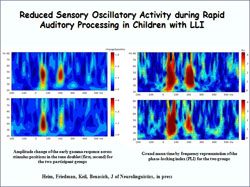 In another 2010 paper that is "in Press" in the Journal of Neurolinguistics, Heim, S., Friedman, J.T., Keil, A., Benasich, A.A author a paper, "Reduced sensory oscillatory activity during rapid auditory processing as a correlate of language-learning impairment." The study examined sensory integration during rapid auditory processing, using electrophysiological measures of oscillatory brain activity for children with LLI and matched controls. Results show significantly reduced amplitude and phase-locking of early (45-75 ms) oscillations in the gamma-band range (29-52 Hz), specifically in the LLI group, for the second stimulus of the tone doublet. This suggests altered temporal organization of sensory oscillatory activity in LLI when processing rapid sequences. (Please click on the graph for a larger view).
In another 2010 paper that is "in Press" in the Journal of Neurolinguistics, Heim, S., Friedman, J.T., Keil, A., Benasich, A.A author a paper, "Reduced sensory oscillatory activity during rapid auditory processing as a correlate of language-learning impairment." The study examined sensory integration during rapid auditory processing, using electrophysiological measures of oscillatory brain activity for children with LLI and matched controls. Results show significantly reduced amplitude and phase-locking of early (45-75 ms) oscillations in the gamma-band range (29-52 Hz), specifically in the LLI group, for the second stimulus of the tone doublet. This suggests altered temporal organization of sensory oscillatory activity in LLI when processing rapid sequences. (Please click on the graph for a larger view).
Earlier This Year
In another exciting paper produced by Dr. Benasich's lab and recently published in Neuroimage (Feb 2010), researchers examine the relation between amygdala size (from structural MRI) and later language. The paper entitled, "Association between the size of the amygdala in infancy and language abilities during the preschool years in normally developing children (Ortiz-Mantilla S, Choe MS, Flax J, Grant PE, Benasich 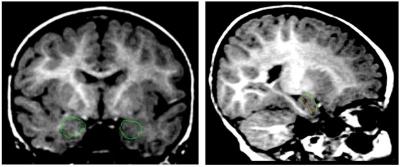 AA.) suggests that the amygdala plays a role in language acquisition. Analyzing brain imaging data collected from 24 infants at 6 months of age, the researchers found that the larger the volume of the right amygdala, the lower the babies score on language tests given at 2, 3, and 4 years of age. Dr. Ortiz-Mantilla (a pediatric neurologist and TDLC fellow) was first author on the paper.
AA.) suggests that the amygdala plays a role in language acquisition. Analyzing brain imaging data collected from 24 infants at 6 months of age, the researchers found that the larger the volume of the right amygdala, the lower the babies score on language tests given at 2, 3, and 4 years of age. Dr. Ortiz-Mantilla (a pediatric neurologist and TDLC fellow) was first author on the paper.
Additional Projects
In addition to the pioneering studies mentioned above, Dr. April Benasich has been involved in other exciting projects. She recently organized and spoke at a Dyslexia Foundation "Extraordinary Brain Seminar": “Developmental Dyslexia: Cross-Disciplinary Insights on Early Precursors, Expression and Remediation”, held at Ashford Castle, Cong, Ireland. The internationally prominent scientists attending tackled issues relating to early precursors, and focused on "pre-dyslexic" populations, to enable earlier identification of those children at highest risk for dyslexia and provide insight into the etiologies, common pathways, neurobiological correlates, and behavioral phenotypes of Developmental Dyslexia. A book for Brookes' publishers is underway, based on the science presented and attempting to put the research presented into a broader context, as well as describing the consensus plans generated by the participants concerning future critical research directions in dyslexia research.
Dr. Benasich was also recently interviewed on The Science Network.
About Dr. April Benasich
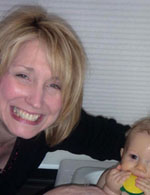
Dr. April Benasich is a Professor of Neuroscience and the Director of the Infancy Studies Laboratory at the Center for Molecular & Behavioral Neuroscience (CMBN), Rutgers University, Newark. She is also the Director of the Carter Center for Neurocognitive Research, one of the Carter Centers for Brain Research in Holoprosencephaly and Related Malformations. Dr. Benasich received her Ph.D.s from New York University in Experimental/Cognitive Neuroscience and Clinical Psychology (1987). She did graduate work at Princeton University, before moving to NYU for her doctorates.
Dr. Benasich's current research, at the Center for Molecular and Behavioral Neuroscience (CMBN), focuses on the study of early neural processes necessary for normal cognitive and language development as well as the impact of disordered processing on infant neurocognitive status in high risk (e.g. family history of language-based learning impairments; very low birth-weight preterms) or neurologically impaired infants. All of the prospective, longitudinal research is conducted on infants from 2 through 84 months.
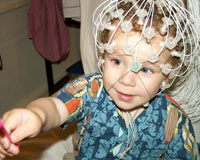 Specifically, she has been studying development of temporally-bounded sensory information processing (shown to be a major predictor of language impairment and dyslexia in older children), the neural substrates that support these developing abilities and the relations seen with emerging language and cognitive abilities from infancy through early childhood. Examination of auditory evoked potentials (EEG/ERPs) and naturally sleeping structural MRI/fMRI provide converging noninvasive physiological measures to her lab’s extensive behavioral battery. In addition, Dr. Benasich has developed a state-of-the-art early assessment battery (including both behavioral and electrophysiological measures), based on previous work in her lab, that allows evaluation of early cognitive and language development in nonverbal, motor-impaired children with early (or genetic) brain insult.
Specifically, she has been studying development of temporally-bounded sensory information processing (shown to be a major predictor of language impairment and dyslexia in older children), the neural substrates that support these developing abilities and the relations seen with emerging language and cognitive abilities from infancy through early childhood. Examination of auditory evoked potentials (EEG/ERPs) and naturally sleeping structural MRI/fMRI provide converging noninvasive physiological measures to her lab’s extensive behavioral battery. In addition, Dr. Benasich has developed a state-of-the-art early assessment battery (including both behavioral and electrophysiological measures), based on previous work in her lab, that allows evaluation of early cognitive and language development in nonverbal, motor-impaired children with early (or genetic) brain insult.
Dr. Benasich’s research has been avidly tracked by the media, with the latest coverage on the PBS special "The New Science of Learning: Brain Fitness for Kids” now being aired. Her findings are groundbreaking, as she has demonstrated for the first time that the ability to perform fine non-speech acoustic discriminations in early infancy is critically important to and highly predictive of later language development in normally developing children as well as children at risk for language disorders. These data further suggest that measures of rapid auditory processing ability may be used to identify and remediate infants at highest risk of language delay and impairment regardless of risk status.
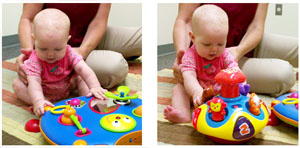 She is also the first to look at "resting" gamma power in the frontal cortex, the "thinking" part of the brain, in children 16, 24 and 36 months old. Research into the adult brain has shown that gamma activity is the 'glue' that binds together perceptions, thoughts and memories. And further suggests that lower levels of gamma power might hinder the brain's ability to efficiently package information into coherent images, thoughts and memories. Analyzing the children's EEGs, she and her research team found that those with higher language and cognitive abilities had correspondingly higher gamma power than those with poorer language and cognitive scores. This work offers significant new insight into the likely role that gamma activity plays in supporting emerging cognitive and language abilities during the first 36 months of life.
She is also the first to look at "resting" gamma power in the frontal cortex, the "thinking" part of the brain, in children 16, 24 and 36 months old. Research into the adult brain has shown that gamma activity is the 'glue' that binds together perceptions, thoughts and memories. And further suggests that lower levels of gamma power might hinder the brain's ability to efficiently package information into coherent images, thoughts and memories. Analyzing the children's EEGs, she and her research team found that those with higher language and cognitive abilities had correspondingly higher gamma power than those with poorer language and cognitive scores. This work offers significant new insight into the likely role that gamma activity plays in supporting emerging cognitive and language abilities during the first 36 months of life.